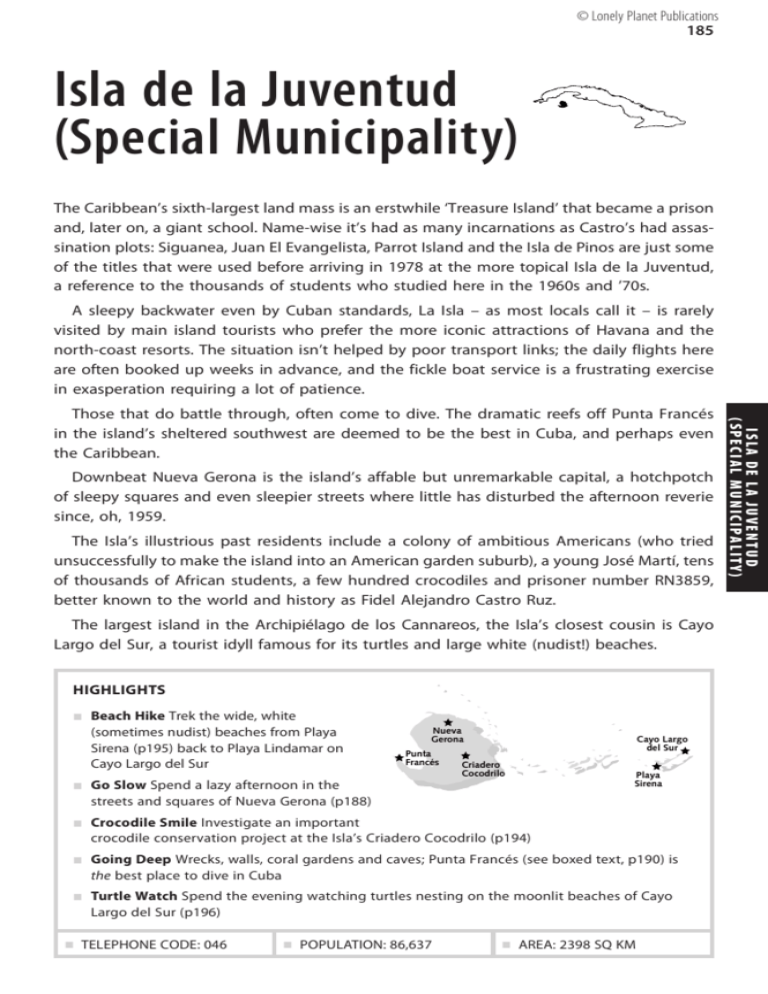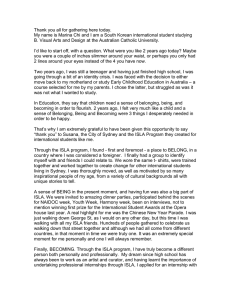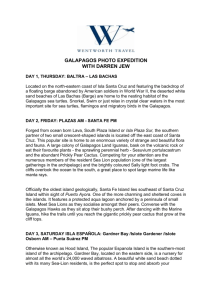Isla de la Juventud (Special Municipality)
advertisement

© Lonely Planet Publications 185 Isla de la Juventud (Special Municipality) The Caribbean’s sixth-largest land mass is an erstwhile ‘Treasure Island’ that became a prison and, later on, a giant school. Name-wise it’s had as many incarnations as Castro’s had assassination plots: Siguanea, Juan El Evangelista, Parrot Island and the Isla de Pinos are just some of the titles that were used before arriving in 1978 at the more topical Isla de la Juventud, a reference to the thousands of students who studied here in the 1960s and ’70s. A sleepy backwater even by Cuban standards, La Isla – as most locals call it – is rarely visited by main island tourists who prefer the more iconic attractions of Havana and the north-coast resorts. The situation isn’t helped by poor transport links; the daily flights here are often booked up weeks in advance, and the fickle boat service is a frustrating exercise in exasperation requiring a lot of patience. Downbeat Nueva Gerona is the island’s affable but unremarkable capital, a hotchpotch of sleepy squares and even sleepier streets where little has disturbed the afternoon reverie since, oh, 1959. The Isla’s illustrious past residents include a colony of ambitious Americans (who tried unsuccessfully to make the island into an American garden suburb), a young José Martí, tens of thousands of African students, a few hundred crocodiles and prisoner number RN3859, better known to the world and history as Fidel Alejandro Castro Ruz. The largest island in the Archipiélago de los Cannareos, the Isla’s closest cousin is Cayo Largo del Sur, a tourist idyll famous for its turtles and large white (nudist!) beaches. HIGHLIGHTS Beach Hike Trek the wide, white (sometimes nudist) beaches from Playa Sirena (p195) back to Playa Lindamar on Cayo Largo del Sur Nueva Gerona Punta Francés Cayo Largo del Sur Criadero Cocodrilo Go Slow Spend a lazy afternoon in the Playa Sirena streets and squares of Nueva Gerona (p188) Crocodile Smile Investigate an important crocodile conservation project at the Isla’s Criadero Cocodrilo (p194) Going Deep Wrecks, walls, coral gardens and caves; Punta Francés (see boxed text, p190) is the best place to dive in Cuba Turtle Watch Spend the evening watching turtles nesting on the moonlit beaches of Cayo Largo del Sur (p196) TELEPHONE CODE: 046 POPULATION: 86,637 AREA: 2398 SQ KM ISLA DE LA JUVENTUD (SPECIAL MUNICIPALITY) Those that do battle through, often come to dive. The dramatic reefs off Punta Francés in the island’s sheltered southwest are deemed to be the best in Cuba, and perhaps even the Caribbean. 186 I S L A D E L A J U V E N T U D ISLA DE LA JUVENTUD (SPECIAL MUNICIPALITY) History The first settlers on La Isla were the Siboney Indians, a pre-ceramic civilization who arrived on the island around 1000 BC via the Lesser Antilles and settled down as hunters and fishermen on the coasts. Naming their new-found homeland Siguanea, they made tools from conches and other shells and left a fascinating set of cave paintings in Cueva Punta del Este (p195). By the time Columbus arrived on these shores in June 1494, the Siboney had long departed (either dying out or returning to the mainland) and the intrepid navigator promptly renamed the island Juan El Evangelista, claiming it for the Spanish crown. But, knotted with mangroves and surrounded by a circle of shallow reefs, the Spanish did little to develop their new possession. Instead La Isla became a hideout for pirates, including Francis Drake, John Hawkins, Thomas Baskerville and Henry Morgan. They called it Parrot Island, and their exploits are said to have inspired Robert Louis Stevenson’s idea for the novel Treasure Island. In December 1830 the Colonia Reina Amalia (now Nueva Gerona) was founded, and throughout the 19th century the island served as a place of imposed exile for independence advocates and rebels, including José Martí. Twentieth-century dictators Gerardo Machado and Fulgencio Batista followed this Spanish example by sending political prisoners – Fidel Castro included – to the island, which had by then reincarnated for a fourth time as Isla de Pinos (Isle of Pines). Aside from its Spanish heritage, La Isla also has a marked English influence. During the late 19th century, some fishing families from the British colony of the Cayman Islands established a settlement called Jacksonville (now Cocodrilo) on the southwest tip of Isla de Pinos; you’ll still occasionally meet people who can converse fluently in English. Additionally, just prior to Cuban independence in 1902, the infamous Platt Amendment included a proviso that placed Isla de Pinos outside the boundaries of the ‘mainland’ part of the archipelago. Some 300 US colonists established themselves here soon after, and only in March 1925 did the US recognize the island as an integral part of Cuba. The Americans stayed and thrived making good business from the island’s first (but not lonelyplanet.com the last) citrus plantations and building an efficient infrastructure of banks, hotels and public buildings. During WWII, the Presidio Modelo was used by the US to inter Axis prisoners and by the 1950s La Isla had become a favored vacation spot for rich Americans who flew in daily from Miami. The decadent party – which by this point included the age-old staples of gambling and prostitution – ended rather abruptly in 1959 with the ascendancy of Fidel Castro. Before the Revolution Isla de Pinos was sparsely populated. In the 1960s and 1970s, however, tens of thousands of young people volunteered to study here at specially built ‘secondary schools’ in the countryside, which now dot the plains in the northern part of the island. Students at these schools worked the fields in shifts, creating the vast citrus plantations that can still be seen today. In 1978 their role in developing the island was officially recognized when the name was changed for the fifth time to Isla de la Juventud (Isle of Youth). Numerous young people from Africa have also studied here, and foreign students still come to the island today, though in smaller numbers. Parks & Reserves Punta Francés is a 60-sq-km National Marine Park on the Isla de la Juventud, about twothirds of which is under the water. Getting There & Around Getting to La Isla requires a bit of effort. There are two options; airplane (book early) and boat (a trip that should be straightforward, but rarely is). The boat will take you to capital Nueva Gerona, a town that is easily negotiated on foot; but to see the rest of the island you need to decipher the unreliable local bus service or commission a car or taxi. There are no tourist buses or trains on the Isla. ISLA DE LA JUVENTUD One of the most welcoming places you will come across in Cuba, Isla de la Juventud is a world apart from anywhere else on the archipelago. The laid-back pace and opportunities for getting (way) off the beaten track here will appeal to escape artists and adventure types alike. While the hotel scene







